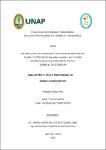Metabolitos secundarios y actividad inhibitoria de hojas y corteza de Spondias mombin Linn y hojas de Alternanthera lanceolata (Benth.) Schinz sobre α- glucosidasa

View/
Date
2022Author
Tello Lopez, Sally
Tuesta Rios, Kary Jacqueline
Metadata
Show full item recordAbstract
Secondary metabolites (MS) constitute an important source of active ingredients for drugs and chemical products, whose pharmaceutical applications are attributed to their functions as analgesics, antivirals, antibacterials, antioxidants, immunostimulants, among others. The objective of this work was to determine the secondary metabolites and inhibitory activity of leaves and bark of Spondias mombin Linn and leaves of Alternanthera lanceolata (Benth.) Schinz on ? – glucosidase. The MS were measured by spectrophotometry and the inhibitory activity was evaluated at concentrations of 100, 250, 500 and 1000 ug/mL of both extracts, using Acarbose as a positive control, in all millipore water was used as a dilution medium. The results of MS phenolic compounds, alkaloids and saponins show that bark of S. mombin Linn obtained majority results. In the inhibitory activity, Acarbose obtained a higher percentage of inhibition compared to the extracts of S. mombin Linn (leaves and bark) and the extract of A. lanceolata (Benth.) Schinz – leaves; likewise, S. mombin Linn - bark showed an IC50=421.92 ug, compared to S. mombin Linn - leaves with an IC50=898.68 ug and A. lanceolata (Benth.) Schinz – leaves with an IC50=1500.00ug In contrast, the positive control Acarbose obtained a lower IC50=356.80 ug; which allows us to conclude that it is the one with the best inhibitory activity. Los metabolitos secundarios (MS) constituyen una fuente importante de principios activos cuyas aplicaciones farmacéuticas se atribuyen a sus funciones como analgésicos, antivirales, antibacterianos, antioxidantes, inmunoestimulantes, entre otros. Objetivo: determinar los metabolitos secundarios y la actividad inhibitoria de hojas y corteza de Spondias mombin Linn y hojas de Alternanthera lanceolata (Benth.) Schinz sobre ? – glucosidasa Metodología: el estudio de tipo correlacional, diseño experimental midió los MS por espectrofotometría y la actividad inhibitoria fue valorada a concentraciones de 100, 250, 500 y 1000 ug/mL para cada extracto, usando como control positivo acarbosa, en ambos casos se usó agua millipore como diluyente. Resultados: la corteza de S. mombin Linn presentó un mayor porcentaje de compuestos fenólicos, alcaloides y saponinas. En la actividad inhibitoria de S. mombin Linn las hojas mostraron una IC50 = 898,68 ug y la corteza una IC50 = 421,92 ug; y las hojas A. lanceolata (Benth.) Schinz una IC50=1500,00 ug. En cambio, para el control positivo acarbosa la IC50 fue 356,80 ug. Conclusiones: acarbosa obtuvo mayor potencia de inhibición sobre la ? – glucosidasa en comparación con los extractos de S. mombin Linn, siendo superior la inhibición del extracto de corteza frente a las hojas y el menos potente fue el extracto de hojas de A. lanceolata (Benth.) Schinz.
Collections
- Tesis [297]

